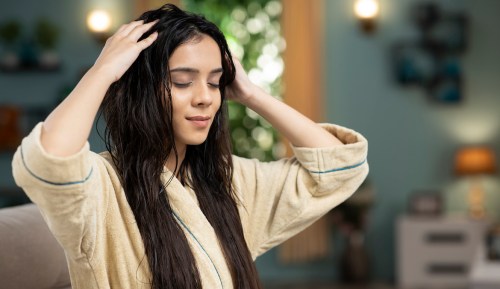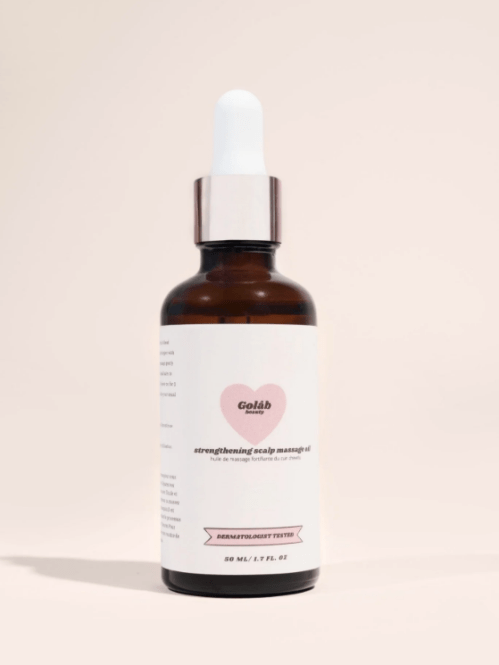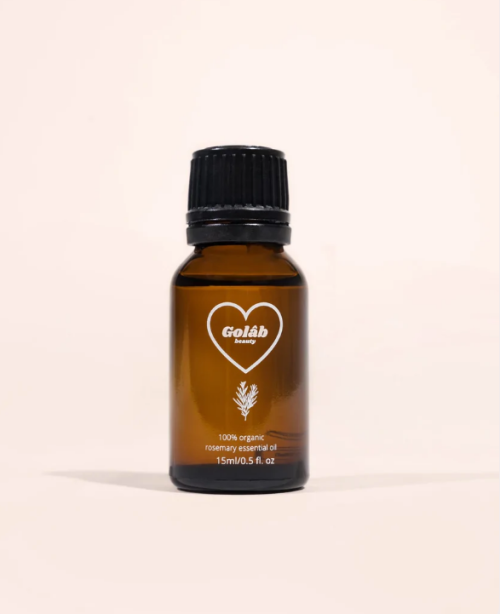Our editors independently select these products. Making a purchase through our links may earn Well+Good a commission
Hair Oiling Has Repaired My Hair From Years of Daily Heat Styling Like Nothing Else
See the hair oiling routine this woman says has left her hair shinier, more defined, and less prone to breakage.

In 2015, I used to straighten my hair daily. I had tried every product under the sun up until then—curl creams, straightening serums, heatless hairstyles, and endless other quasi-solutions—but nothing seemed to give me the results I was after. It wasn’t until my senior year of high school that I realized how much damage had been done to my hair. I’m also one of the many South Asian women who struggle with polycystic ovarian syndrome (PCOS). Often quietly, we experience an excess of androgens—or male hormones—that can lead to symptoms of hair loss, in this case androgenic alopecia, or excessive hair growth.
Experts in This Article
Until the rise of TikTok, specifically hairtok, I thought I was out of solutions for my hair. But as trichologists, endocrinologists, and Ayurvedic practitioners began posting information online, I was able to find a collection of holistic and evidence-based solutions, with hair oiling, an ancient Ayurvedic treatment where scalp health meets self care, being one of the most effective for me.
For most of my adult life, I’ve been rubbing oil into my hair—focusing the application on my scalp and ends—the night before I plan to wash it. As a South Asian woman, I’ve also grown up in a culture that views hair oiling as an essential part of hair health. To this day, my grandmother in India oils and brushes her hair every night; having long, thick, silky hair is ingrained in us from the day we’re born.
And yet, I’ve learned so much from hairtok and the interpretations of Ayurvedic medicine in the West as well, and it’s making me rethink the ancient practice and how it can help solve a modern set of problems, primarily damage from heat styling and processing.
The Ayurvedic approach to hair
Ayurveda is derived from the Sanskrit word ayur, meaning “life” or “vital power.” Its suffix, veda, means “knowledge,” roughly translated Ayurveda means “knowledge of life.” Originating in India more than 3,000 years ago, Ayurveda is composed of both preventive and curative health care—think herbal remedies, yoga/meditation, and diet tweaks. Ayurveda is rooted in the idea that our mind, body, and soul are interconnected with the outer world, causing an imbalance when our personal needs aren’t met.
All of this can translate into the health of our hair, which Carrie Jones, ND, a board-certified naturopathic endocrinologist specializing in women’s hormonal health, says is highly reactive. “Everything from chemicals, to how often you wash and brush it, to the oils you put on it,” can impact your hair, she explains. “We think hormones have only to do with our period or fertility, but really our little hair follicle is paying attention.”
From a holistic lens, Ayurveda addresses hair loss through three basic principles, referred to as doshas: vata (air), pitta (fire), and kapha (earth). When we experience hair loss, it is believed to be a result of excessive pitta, which inflames our hair follicles and creates a hormonal imbalance within us. These natural energies help us understand our health issues through Ayurvedic medicine, and comprehensively address hormonal imbalances that can lead to hair loss and thinning.
When it comes to hair loss, Ayurveda encourages its followers to examine every aspect of their lives: How do you manage stress? What are your go-to snacks? Do you stay active? And, most importantly, what does your pre-shower hair-care routine look like? Drinking herbs like ashwagandha, holy basil, and turmeric help improve our natural responses to stress, sleep, anxiety, and thyroid health, which can all impact our hormone levels, according to Dr. Jones, who emphasizes that native Ayurvedic practitioners from Asia are owed credit for these ideas. In addition, maintaining a clean scalp, regularly practicing hair oiling, and eating foods for a healthier scalp and hair like walnuts, pumpkin seeds, and salmon, as well as supplements that block DHT, a hormone that can shorten your hair’s growth cycle and reduce the size of hair follicles, can all help too.
Here’s how I go about my hair oiling routine
I’ve tried almost every hair oil I’ve been able to get my hands on. From the jasmine and coconut oils found in the back shelves of our local Indian grocery store to the brand-name bonding oils sold at Sephora, I consider myself an expert in the trial and errors of maintaining hair health. But the one I love the best is Gôlab Beauty’s strengthening scalp massage oil ($35), which combines Indian gooseberry fruit, castor bean, sesame seed, and organic flaxseed—all of which are rich in omega 3 and 6 and dermatologist-tested—to target different hair and scalp concerns. It’s already done wonders for my hair. In the two months that I’ve been using it, my hair is shinier, more defined, and less vulnerable to breakage, and I have new growth along my hairline.

Gôlab Beauty, Strengthening Scalp Massage Oil — $35.00
First, I use a bamboo brush to detangle my hair for five to 10 minutes, which helps boost blood circulation. Then, I part my hair into sections and apply hair oil at the roots of each area, paying extra attention to where thinning is more obvious. After applying the oil into the affected areas, I finish by taking some extra oil in my hands and giving myself a scalp massage. I braid my hair and let the oil sink in for two to three hours before washing it out in the shower.
While shampooing, I use Gôlab Beauty’s organic rosemary essential oil ($20) and apply a few drops into my shampoo before emulsifying it between my hands. The product is described as a “natural vasodilator,” meaning it helps open up blood vessels, which in turn boosts blood flow (which is important for a healthy scalp and hair). Afterward I style my hair as usual.

Gôlab Beauty, 100% Organic Rosemary Essential Oil — $20.00
Although Gôlab Beauty’s products are an effective favorite of mine, any plant-based oil will do. You can practice hair oiling at home with coconut, jasmine, pumpkin seed, or castor oil, to name a few.
I was influenced to try rosemary oil (another great option) by TikTok creator Yasamine Durali, who was first introduced to holistic hair care on the social media platform after years of trying to change her own hair. “I had seen people talk about rosemary oil and how it was really helpful for hair growth,” she explains. “And I was just consistent with it. I started losing less hair in the shower, and when I got my hair cut she noticed significant growth.”
As Durali notes, consistency is what drives the practice of hair oiling. In Ayurveda, it’s recommended that hair be oiled and washed two to three times a week, while scalp massages should be practiced twice a day. Patience and consistency are also a large component of the Ayurvedic lifestyle, since results are typically seen after around six months of hair oiling.Beyond the modern wellness movement, hair oiling and scalp massages have been passed down as an act of bonding. “Generations of women have been doing this before us,” Durali emphasizes. To honor them, let’s trust the process.
Sign up for the Well+Good SHOP Newsletter
Get exclusive deals on wellness, beauty, fitness, and food products that have been hand-picked by our editors.
Got it, you've been added to our email list.










